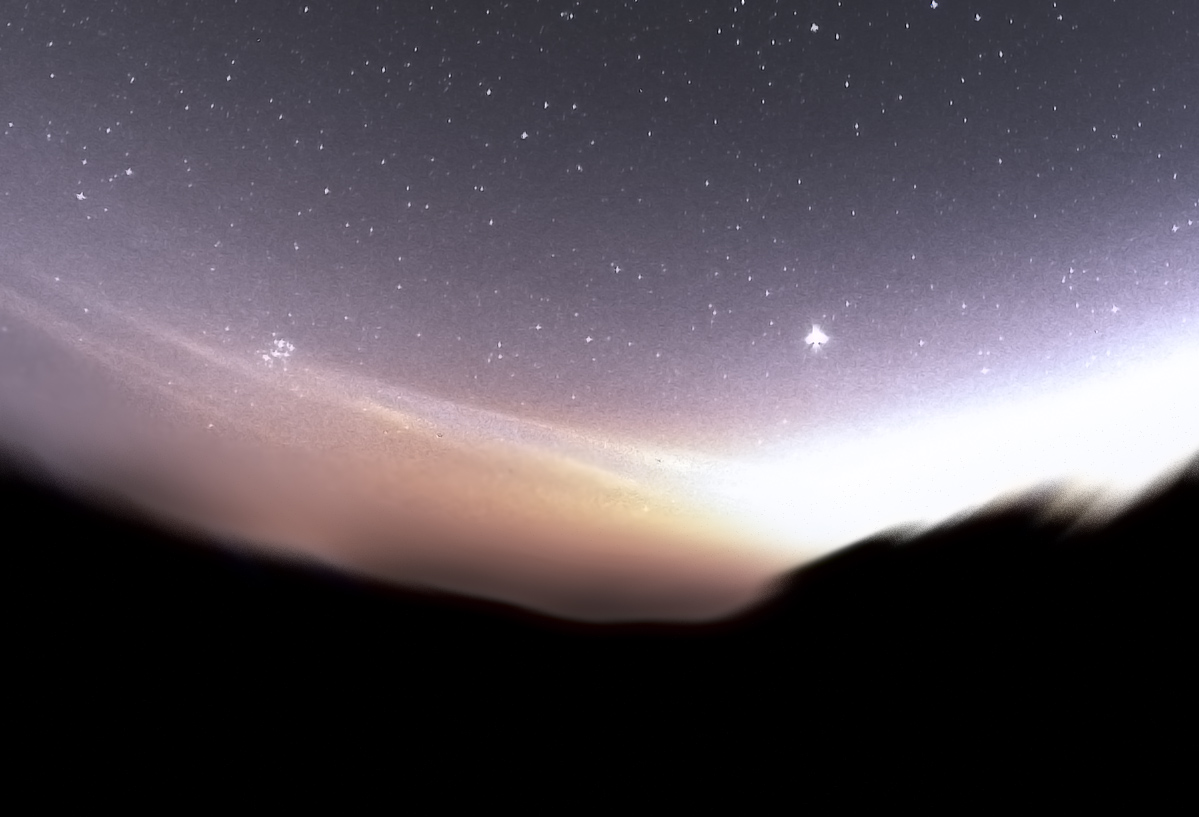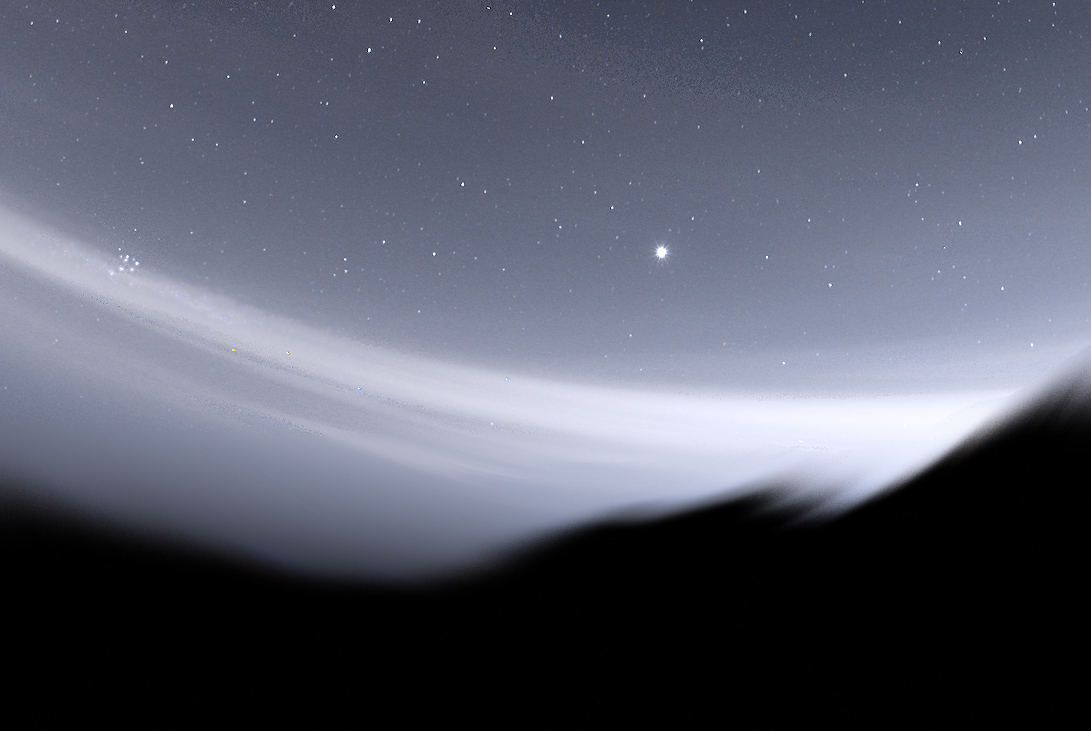The Starry Night, 254 :: home :: |
About that Fisheye
(1) Others have observed that the lens cap likes to fall off. It certainly does. Let me say this about that: small tabs of black electrical tape on each of the (unremovable) minimal lens hood's "ears" at the top and bottom shim the too-loose fit and pretty well take care of this irritation. I could also imagine carefully mashing / warping / adjusting the lens cap in a vise, but that could very easily get out of hand. Electrical tape works. (2) The oft-described "ingenious" lens cap has a threaded insert. Unscrew it and it becomes a circular aperture rather than a cap. The idea is to crop the field and thereby produce familiar circular fisheye images that fit within a 24x36mm frame. This scheme is just as bizarre as it sounds, and it does not work worth a damn. The field of view through the aperture is indeed circular and it does fit within a full-frame sensor's format, but it is not nearly wide enough to produce a convincing or particularly useful fisheye view. It's maybe 150 degrees. I haven't measured it, because I guarantee that I will never, ever use it. The edges are predictably fuzzy. I grant that it is a nicely executed piece of hardware, but it is folly. If the threaded metal cap allows for the placement of standard filters then it is a potentially useful feature, especially for crop-sensor cameras on which the lens behaves more or less as a full-frame rather than circular fisheye. That is not much of a silk purse, but there it is. Without this shenanigan, the lens produces an image circle 180 degrees across, as a fisheye should, but that hemispheric image spills over the full-frame format at the top and bottom -- just a tidge. It's a compromise between lots of pixels and a full circle. Works for me, but maybe not for thee. (3) Trivia: many examples shown online have "Fisheyes lens 7.5mm/2" engraved on the side of the lens body, but on mine the engraving has been corrected to "Fisheye lens 7.5mm/2". (4) The lens body is all metal and feels as solid as a hand grenade. Control rings turn smoothly, though they are tiny. It requires some care not to muddle the focus when adjusting the aperture ring. F-stops (plus half-stops from F2 to F5.6) are crisp detents easily felt in the dark. Quibbles aside, it's a talking dog! It's a fisheye lens with an F2.0 maximum aperture! Does it work? Yes it does. It is perfectly useful at full-aperture, but to nobody's surprise at this price point, it is not perfect ("this price point" is $117, open box, from B&H). However, with some care, it is damned good at F2.0. The one or two lenses I own that are genuinely sharp wall to wall at full aperture cost 5 - 15x as much as this little guy (for the record, those would be a somewhat vintage Zeiss 25mm F2 Distagon and a Sigma 105mm F1.4 "Art"). Here's deep twilight on September 3 from the community lot: Go ahead: click and and make that big. The 1,400 pixel version is not really big enough to see its liabilities. It looks good even at full resolution, though the photo is noisy since it is a stack of only four 2-second exposures at F2.0 (Canon R6, ISO 1600, tracked on an iOpton startracker and the subframes aligned in Pixinsight). The yellow glow at left is metropolitan Granite Falls lighting up mist over the Catawba River; the last light of sunset is at right beyond the flood-lit boatyard. When used casually under the stars and focused simply by turning the focus ring to the infinity stop, my example is sharp at the edges and fuzzy in the middle. This is profoundly true at F2.0, undeniable at F2.8, and still true at F4. The proposition begins to become doubtful at F5.6 and it is patently false at and beyond F8. Nobody wants to take an F8 lens out under the stars, of course, but even that is not hopeless in an age when CMOS sensors can do good work at ridiculous ISOs, and software allows astronomical images to be stacked as high as needed to limit noise. Fortunately, the center can be brought into focus by backing the focus ring off from the infinity mark. Somewhere between the stop and the best center focus is an optimal setting for good overall focus. With luck, closing down a bit will keep both center and edge in focus. Just so. (Lest anyone think I am dissing the fisheye for this, no: that is a familiar strategy to deal with a curved focal "plane" under the stars when using any fast lens worth less than a mortgage payment or two, and dealing with lenses that focus "beyond infinity" is routine at any price point.) Dead sharp focus in the center requires a relatively hefty twist of the focus ring back to almost the "0.5m" mark. Picking a star a little more than halfway from center to edge (call it 60-70%) seems to produces an excellent compromise. Save some time and squinting: referring to the focus ring rather than live view, that point is just beyond the "1m" mark (the last mark before infinity). Even F2.0 looks pretty good edge to edge with the focus set there (see example above). F2.8 looks really good, and by F4.0, things are about as good as I can ask for (see detailed crops below). If you want perfection (with this sample at least) set the focus between the 1m mark and the first "lobe" of the infinity symbol (somewhere around 1.2m) and use F5.6. If you'll settle for "perfectly OK," rather than perfect "simpliciter," use any F-stop you like, depending on the subject. Bring on the Geminids; bring on an aurora; bring on the Zodiacal band. 09/15/2023. Some examples under a darker sky. The actual framing of the circular image is shown in the 4-frame stack above. The top and bottom are truncated. By insuring that those areas of the sky are hidden by trees or terrain, the full circular image can be approximated easily enough. I've expanded the canvas and added a line to mark the image circle in this example just for sport:
That's 50, 15-second exposures at F2.0 and ISO 1600. Click to enbiggerate because white screen borders make it look pretty dim. At this scale, the difference between that image and a stack of 30-second, ISO 3200, F4.0 images is negligible. So yeah, use F2.0 for meteors and other transient phenomena. In the full-rez original at F2.0 the outer several percent are troubled, so use that aperture with some foresight. Here, for example, is a tight crop of Jupiter and the Pleiades rising from the murk first at F2.0 then at F4.0 --clicking will bring up the full, original resolution of the stacked images.
The mess at F2.0 is due to many issues, most but not all of them optical. By F4, there's a tiny bit of radial coma left in the image but some of the post is still, uhm, "suboptimal." Let's try 5.6 and tweak the focus point just a little more. Or live with it.
:: top ::
|
© 2023, David Cortner



